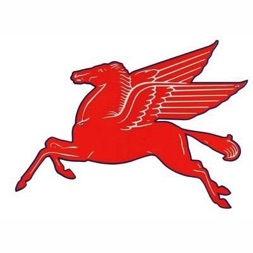









Mobile
Historical Society of
Pottawattamie County
County Seat Council Bluffs, Iowa

When the Lincoln Highway opened in 1916 Council Bluffs found itself right on the nation’s only transcontinental automobile route. Other long distance roads quickly followed. Automobiles became common and a whole new industry emerged to service them.
Council Bluffs’ Monarch Manufacturing was quick to recognize the potential and adjust their product line to capture the growing customer base in the automobile industry with motor oil and gasoline sales under the name MonaMotor Oil. They latched onto another new innovation— radio— as a way to promote their product with the call sign K-OIL. The company’s oil cans, grease containers, and even spark plugs promoted KOIL and the station in turn popularized the company.
Towns competed aggressively for long distance highways, which ran right through the heart of them. That this brought a lot of traffic wasn’t an issue, it was the whole point— traffic meant business. To attract the long distance motorists the service stations lined the main thoroughfares, becoming the most common type of businesses along Broadway. Most stations had just two or three pumps and were operated by their owner. Brands were many; in addition to MonaMotor local and regional chains L.L. Coryell, Universal Oil, and Central States were common, as well as national names Sinclair, Skelly, Phillips 66, and the Texas Fuel Company (later Texaco).
Range of services provided was up to the imagination, skill, and ambition of the proprietors. Bernie Reitz made ice for coolers, giving his Skelly Station at 27th and West Broadway an advantage over competitors. The Madarin Tourist Village offered a place to camp, a motel, and cafe in as well as gas. Ray Payne, a top notch mechanic, provided repair services at his Standard Oil station on Highway 6, plus a large selection of groceries, a significant plus in an era when stand alone grocery stores weren’t open on Sundays. Cleaning the windshield and checking the oil was part of the service; air for tires and roadmaps were complementary.
The number of stations fostered competition. Architecture evolved beyond just a canopy to keep the attendant dry to sometimes elaborate styles to attract the motorist, though most of the stations in Council Bluffs kept with simple and functional designs. As most stations were independently owned no two looked exactly alike; each reflected the owner’s taste and budget. Periodic “gas wars” were common, with a proprietor undercutting his competition. Gas stations followed the lead of grocery stores to build loyalty among customers with trading stamps, and hosted giveaways as diverse as fine art prints to antenna bananas for one’s car aerial. Holiday station/stores appeared in the area in the 1960s, issuing their own brand of trading stamps that could be used for discounts on items ranging from groceries to tape recorders available right at the station. By the 1970s many stations were offering a free car wash with a fill up.
The trading stamps, car washes, and window washing attendants came to an end in May, 1973. An oil embargo made gasoline difficult to obtain. There were occasional weekdays evenings in Council Bluffs were there were no service stations open at all. Stations that didn’t have gas couldn’t make sales, incentives or not; the stations that did have it had customers lined up for blocks.
As with most other retail the mom and pop shops eventually gave way to large scale operations; truck stops and super stations gradually took over. As oil prices rose consumers became even more cost conscious. To lower fees self-service gas pumps were introduced that allowed the customer to fill their own tank and pay at the pump, but the initial investment of such technology was high for the station owner, giving an advantage to large companies over the small operator. Many legacy stations found themselves on prime real estate, creating an incentive to sell out. As traffic volume increased the new interstate highways bypassed town; many stations survived on local traffic but the heyday of the cross country traffic along Broadway was over.